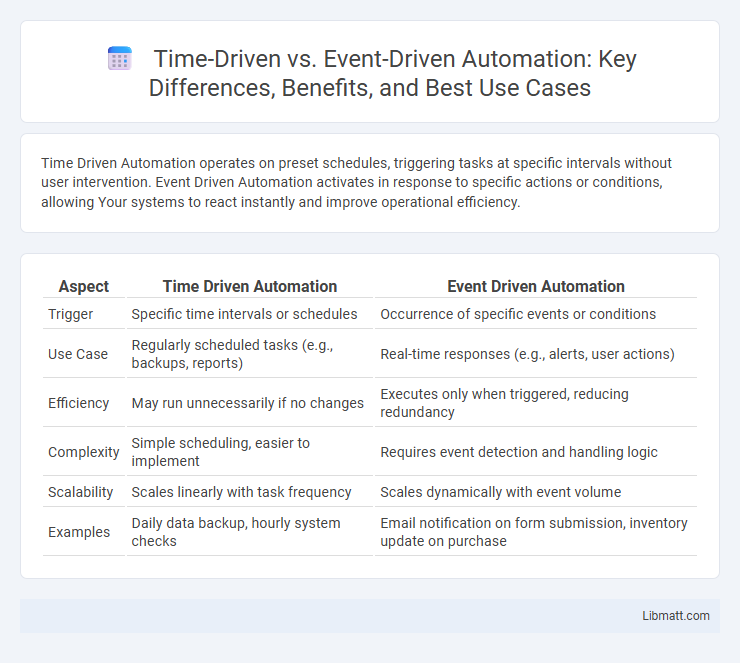Time Driven Automation operates on preset schedules, triggering tasks at specific intervals without user intervention. Event Driven Automation activates in response to specific actions or conditions, allowing Your systems to react instantly and improve operational efficiency.
Table of Comparison
| Aspect | Time Driven Automation | Event Driven Automation |
|---|---|---|
| Trigger | Specific time intervals or schedules | Occurrence of specific events or conditions |
| Use Case | Regularly scheduled tasks (e.g., backups, reports) | Real-time responses (e.g., alerts, user actions) |
| Efficiency | May run unnecessarily if no changes | Executes only when triggered, reducing redundancy |
| Complexity | Simple scheduling, easier to implement | Requires event detection and handling logic |
| Scalability | Scales linearly with task frequency | Scales dynamically with event volume |
| Examples | Daily data backup, hourly system checks | Email notification on form submission, inventory update on purchase |
Introduction to Automation Paradigms
Time-driven automation executes tasks based on predetermined schedules or time intervals, ensuring consistent and predictable operations in systems like backup processes or batch jobs. Event-driven automation triggers actions in response to specific events or changes in system states, enabling real-time responsiveness critical for applications like fraud detection or IoT device management. These paradigms optimize workflow efficiency by aligning automation strategies with operational demands and contextual triggers.
Defining Time Driven Automation
Time Driven Automation operates on pre-set schedules, executing tasks at specific intervals regardless of external triggers. Commonly used in processes like data backups, report generation, and system maintenance, it ensures operations occur consistently and predictably. This approach is essential for routine tasks requiring timely execution without dependency on real-time events.
Exploring Event Driven Automation
Event-driven automation reacts to specific triggers or events, enabling real-time responses and enhancing operational agility. This model utilizes sensors, APIs, or user interactions to initiate workflows immediately, reducing latency and improving efficiency. Businesses leveraging event-driven automation benefit from improved scalability and dynamic process adjustments aligned with actual occurrences.
Key Differences Between Time and Event Driven Approaches
Time-driven automation operates on predefined schedules, triggering tasks at specific intervals such as hourly, daily, or weekly, ensuring consistent and predictable execution. Event-driven automation, by contrast, responds dynamically to real-time occurrences like user actions, system changes, or external signals, enabling immediate and context-sensitive responses. Your choice depends on whether your workflows require routine timing consistency or responsive, on-demand processing based on specific events.
Use Cases for Time Driven Automation
Time Driven Automation excels in scenarios requiring repetitive, scheduled tasks such as daily data backups, routine report generation, and automated email campaigns. Your business benefits from consistent execution without manual intervention, ensuring tasks occur at precise intervals like hourly, daily, or weekly. This approach is ideal for maintenance activities, batch processing, and system health monitoring where timing is critical.
Use Cases for Event Driven Automation
Event Driven Automation excels in real-time response scenarios such as fraud detection, customer support chatbots, and IoT device management where immediate action on specific triggers is crucial. It enhances operational efficiency by automating workflows based on changes in data or user behavior, making it ideal for dynamic environments. Your business benefits from faster decision-making and personalized interactions with automated event-driven systems.
Advantages of Time Driven Automation
Time Driven Automation offers consistent, scheduled execution of tasks, ensuring regularity and predictability in workflow processes. It reduces manual intervention by automatically triggering actions at predefined intervals, improving operational efficiency and resource management. Your business benefits from enhanced reliability and the ability to align automation precisely with time-based goals or compliance requirements.
Advantages of Event Driven Automation
Event Driven Automation offers superior responsiveness by triggering actions instantly based on specific events, reducing delays compared to Time Driven Automation's fixed schedules. This approach enhances efficiency and accuracy, as processes run only when necessary, conserving resources and minimizing idle cycles. By aligning automation with real-time data and user interactions, Your systems become more adaptable and capable of handling dynamic workflows seamlessly.
Challenges and Limitations of Each Approach
Time-driven automation faces challenges such as rigidity in handling unpredictable events and potential inefficiencies from executing tasks at fixed intervals regardless of need. Event-driven automation struggles with complexity in event detection and coordination, risking missed triggers or system overload due to excessive event processing. Both approaches require careful balancing of responsiveness, resource utilization, and scalability to mitigate limitations in dynamic environments.
Choosing the Right Automation Strategy
Choosing the right automation strategy involves understanding the key differences between time-driven and event-driven automation to optimize your operational efficiency. Time-driven automation executes tasks at predetermined intervals, ideal for routine processes requiring consistency, while event-driven automation triggers actions based on specific events, enhancing responsiveness to real-time changes. Your decision should align with your business goals, process complexity, and the need for flexibility to maximize productivity and resource allocation.
Time Driven vs Event Driven Automation Infographic

 libmatt.com
libmatt.com